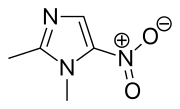Dimetridazole
 | |
| Clinical data | |
|---|---|
| AHFS/Drugs.com | International Drug Names |
| ATCvet code | |
| Identifiers | |
| |
| CAS Number | |
| PubChem CID | |
| ChemSpider | |
| UNII | |
| KEGG | |
| ChEMBL | |
| ECHA InfoCard | 100.008.184 |
| Chemical and physical data | |
| Formula | C5H7N3O2 |
| Molar mass | 141.128 g/mol |
| 3D model (JSmol) | |
| |
| |
| (verify) | |
Dimetridazole is a drug that combats protozoan infections. It is a nitroimidazole class drug.[1] It has been banned by the Canadian government as a livestock feed additive.[2]
It used to be commonly added to poultry feed. This led to it being found in eggs. Because of suspicions of it being carcinogenic its use has been legally limited but it is still found in the eggs.[3][4]
See also
References
- ↑ Dalton, P. (1996). "Use of dimetridazole in gamebirds". The Veterinary record. 139 (16): 399. PMID 8913016.
- ↑ Canadian Food Inspection Agency update Archived May 7, 2005, at the Wayback Machine.
- ↑ Posyniak A, Semeniuk S, Zmudzki J, Niedzielska J, Biernacki B (1996). "Residues of dimetridazole in eggs after treatment of laying hens". Veterinary Research Communications. 20 (2): 167–74. PMID 8711897. doi:10.1007/bf00385638.
- ↑ Cannavan A, Kennedy DG (1997). "Determination of dimetridazole in poultry tissues and eggs using liquid chromatography-thermospray mass spectrometry". The Analyst. 122 (9): 963–6. PMID 9374025. doi:10.1039/a703193i.
This article is issued from
Wikipedia.
The text is licensed under Creative Commons - Attribution - Sharealike.
Additional terms may apply for the media files.